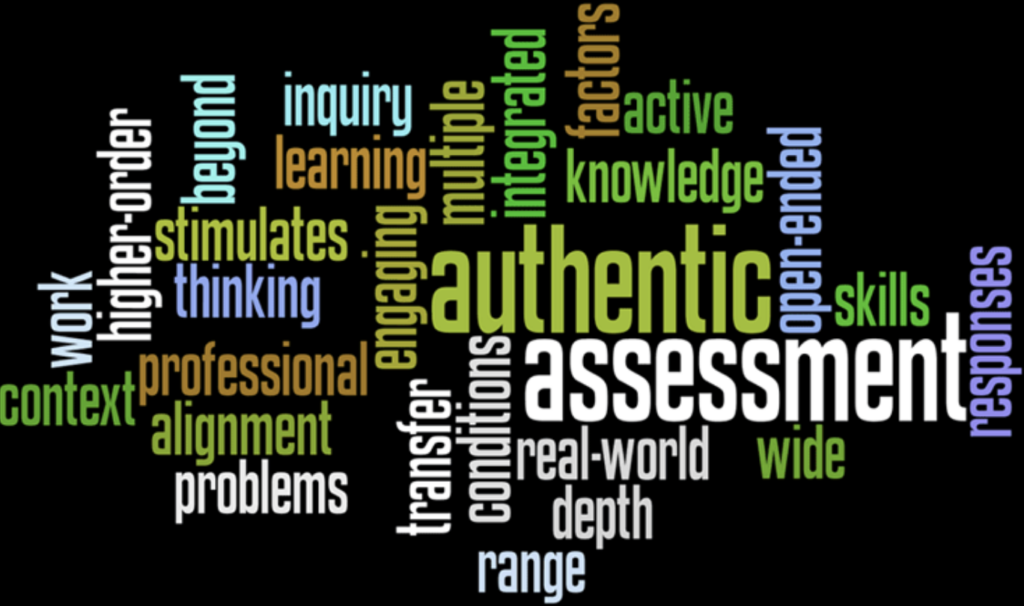By Marion J. Tate, Ph.D., CETL Assistant Director for Educational Development

LockDown Browser and other tools are valuable for upholding academic integrity during assessments, as they help prevent cheating and unauthorized access to information. The effectiveness of these tools is significantly enhanced when paired with well-designed assessments. When assessments are effective, they reduce opportunities for dishonesty and engage students in meaningful ways by encouraging critical thinking and skill development.
In face-to-face or virtual settings, well-designed assessments are crucial to maintaining academic integrity. Authentic assessment is one effective design strategy that faculty can use to help maintain assessment integrity. The definition of authentic assessment and three related methods are discussed below.
Definition
Authentic assessment is an assessment strategy that incorporates real-life connections, significant meaning, and knowledge integration (Tate, 2024). Authentic assessment methods include interviews, community/problem-based projects, logs, written and oral reports, performances, portfolios, case studies, and digital storytelling. These assessments promote active participation, original work products, and solutions to real-world problems by allowing multiple responses to a single inquiry rather than one correct answer (Owen et al., 1994), as in the case of multiple choice or true/false questions.
Methods
Interviews
Interviews, as a method of authentic assessment, help to promote integrity by requiring students to actively engage in a unique, real-world dialogue that is difficult to replicate or plagiarize. For example, students must prepare thoughtful questions, interact with their interviewee, reflect on their experience, and report (in their own words) the outcome based on the information gathered. The personalized nature of the task ensures that the final product is individualized, making it harder for students to copy from others or use unauthorized assistance. Additionally, the interview process mediates critical thinking and develops the learner’s interpersonal communication skills, which promotes authentic learning over rote memorization.
Community-Based Projects
The community-based project is another method of authentic assessment. It helps to promote integrity by requiring students to engage in hands-on activities unique to their environment and interactions. For example, students might collaborate with a local organization to address a community need, document their experiences, and propose solutions. This process involves direct involvement, critical thinking, and personal reflection, which are individualized and challenging to replicate. The priority given to active participation and original outcomes ensures that students are evaluated based on their genuine efforts and contributions, which promotes academic integrity.
Logs
Using logs as a method of authentic assessment helps to promote integrity by requiring students to document their ongoing, individualized progress over time. Students might maintain a log of their daily study habits, lab experiments, or project milestones, reflecting on their learning process and outcomes. Since logs are based on personal experiences and include detailed, chronological entries, they are inherently specific to each student. This individualized approach makes fabricating or copying entries difficult, ensuring the assessment reflects authentic engagement and effort.
Overall, authentic assessment methods encourage student choice, foster engagement, and provide multiple opportunities for practice and revision. For example, students working on a collaborative-based activity and tasked with creating a podcast on a topic of their choice are provided multiple opportunities to research, write, record, and edit in an engaging and authentic way.
Additional Strategies for Assessment Design
In addition to the authentic assessment strategy discussed here and the various methods used to employ them, other general approaches can support effective assessment design while promoting academic integrity. These include allowing students to participate in the assessment design process (e.g., giving students a voice regarding type of assessment and/or related details), which fosters buy-in, boosts confidence, and enhances their understanding of the process. Furthermore, fostering originality by creating assignments that take a fresh perspective on course material, are all effective strategies. Other strategies include breaking larger assessments into smaller incremental tasks that lead to the final product and incorporating personal reflections as part of assignment submissions (Fordham University, n.d.).
Conclusion
Well-designed assessments are essential for promoting academic integrity while enhancing student learning. Authentic assessment methods, such as interviews, community-based projects, and logs, engage students by connecting tasks to real-life scenarios and fostering originality. When these assessment methods are combined with strategies such as allowing student input, breaking tasks into manageable steps, and including reflective elements, they help faculty create meaningful, fair assessments that reduce opportunities for dishonesty while promoting genuine effort and deeper understanding.
References
Fordham University. (n.d.). General strategies for online exam design. Faculty of Arts and Sciences. Retrieved from https://www.fordham.edu/academics/faculty/faculty-of-arts-and-sciences/covid-19-teaching-resources/assessment/online-exams-proctoring-recommendation-and-guidance/general-strategies-for-online-exam-design/
Owen, J. M., & Others. (1994). Genuine reward: Community inquiry into connecting learning, teaching, and assessing.
Tate, M. J. (2024). Social interaction styles contributing to ethnic identity of Pakistani immigrant mother-daughter dyads in virtual museums (Doctoral dissertation).